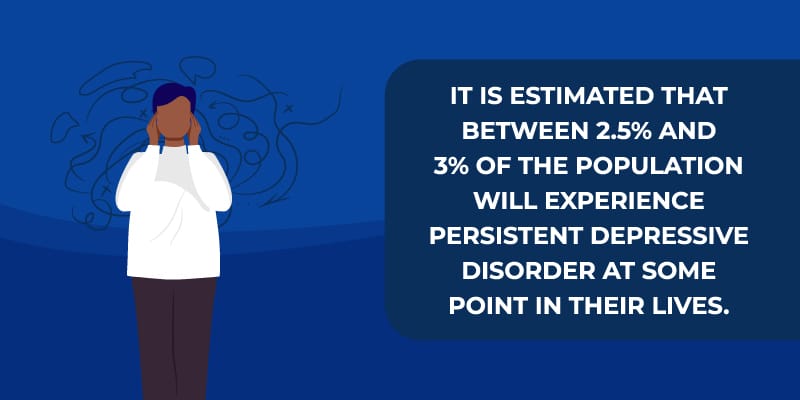

Persistent Depressive Disorder Diagnosis and Treatment
Persistent depressive disorder can affect multiple areas of an individual’s life. Read on to learn more about symptoms and treatment methods.
Table of Contents
Reach Out to Learn More
What Is Persistent Depressive Disorder?
Everyone experiences periods of intense sadness at some point in their lives. For most, sadness and other effects on mood that result from a specific event or situation pass with time. For others, this is not the case, which may lead to a mental health condition called persistent depressive disorder.
Depression is a term often used to describe the emotions someone experiences when they are sad. When depressed, it is also common to experience changes in appetite, problems with sleep, and a general lack of desire to participate in activities or obligations one usually enjoys.
Understanding Persistent Depressive Disorder (PDD) Disorder
Common Types of Depression Disorder
- Major depression (major depressive disorder)
- Bipolar disorder
- Seasonal affective disorder
- Situational depression
- Postpartum depression
- Persistent depressive disorder
Persistent depressive disorder and major depressive disorder are similar in many ways, and it is not uncommon for misdiagnosis to occur.
A Closer Look at Major Depressive Disorder Disorder
Understanding Persistent Depressive Disorder
Symptoms of Dysthymia
- A loss of interest in daily activities
- Decreased productivity
- Low self-esteem
- Feelings of hopelessness
Note About Persistent Depressive Disorder
Types of Dysthymia
- Pure Dysthymic Syndrome: Depression symptoms will be persistent and significant, but will not meet the diagnostic criteria for a major depressive episode.
- Persistent Major Depressive Episodes: The person reports experiencing several severe major depressive episodes over a period of two years. Unlike major depression, however, the symptoms do not worsen or improve with time. Instead, they remain consistent throughout.
- Intermittent Major Depressive Episodes: An individual will experience some episodes of major depression with chronic depressive symptoms. To be diagnosed with this type of dysthymia, one must experience eight or more weeks of major depression in the previous 24 months.

Is Persistent Depressive Disorder a Disability?
- Depressed mood
- Diminished interest in activities
- Appetite disturbances
- Sleep disturbances
- Psychomotor agitation
- Decreased energy
- Difficulty concentrating or thinking
- Feelings of guilt
- Suicidal thoughts
Prevalence of This Condition
Causes and Risk Factors
Like several similar mental health concerns, researchers do not fully understand the specific causes of dysthymia. Studies suggest several causes and risk factors contribute to the development of persistent depressive disorder.
Genetics
Brain Chemistry
Life Events
Risk Factors
- Child abuse
- Family history of depression
- Character traits such as negativity and low self-esteem
- Brain injury
- Long-term illness
Persistent Depressive Disorder in Children
Youth with dysthymia often experience symptoms of other mental health concerns, such as anxiety and substance use disorders.
Important Note About Persistent Depressive Disorder in Children
- Excessive stress
- Family history
- Trauma, such as abuse, neglect, or loss of a parent or loved one
- Long-term health challenges
- Developmental or learning delays
- Co-occurring mental health diagnoses
- Experimentation with drugs or alcohol

Diagnosis of Persistent Depressive Disorder
Mental health experts can diagnose dysthymia through exams and tests. Three main evaluations are involved in the process, including:
Physical Exam
A medical evaluation is crucial to rule out or diagnose any underlying medical conditions that may contribute to depressive symptoms.
Lab Tests
Psychological Evaluation
A psychological assessment determines if patients have persistent depressive disorder or other closely related conditions, such as major depressive disorder, bipolar disorder, or seasonal affective disorder.
- 70% of those with borderline personality disorder also have persistent depressive disorder.8
- Dysthymia co-occurs with substance use disorders between 30% and 40% of the time.9
- Up to 75% of those with dysthymia develop major depressive disorder. This is sometimes called “double depression.”10
Diagnostic Criteria
- Poor appetite or overeating
- Insomnia or hypersomnia
- Low energy or fatigue
- Low self-esteem
- Poor concentration or difficulty making decisions
- Feelings of hopelessness
- Frequent complaints of physical ailments such as headache, stomach ache, or fatigue
- Loss of enjoyment in usual activities and hobbies
- Thoughts of or attempts at self-harm

Treatment for Persistent Depressive Disorder
Medications
- Selective serotonin reuptake inhibitors (SSRIs), such as Prozac, Lexapro, Paxil, and Zoloft.
- Tricyclic antidepressants, including Elavil, Tofranil, and Vivactil.
- Serotonin and norepinephrine reuptake inhibitors, such as Effexor and Cymbalta.
- Other medications may also be used, such as Remeron and Wellbutrin.
Talk Therapy
What to Expect During Therapy
Other Approaches to Healing
In addition to psychotherapy and medication, several alternative or complementary treatment options can further alleviate depression symptoms.
- Regular exercise
- Eating a healthy and balanced diet
- Avoiding alcohol and substance use
- Engaging in hobbies or other activities
- Connecting with a strong support network of family and friends
- Remaining engaged with your treatment provider and therapy team

Persistent Depressive Disorder Treatment Options at J. Flowers Health Institute
Our highly-qualified staff prioritizes the health and well-being of each patient. Our team of caring and compassionate care providers will work with you or your loved one to develop a plan of care that aligns with your unique treatment needs and goals.
How Can We Help?
We can also provide holistic treatments and a Bespoke Stabilization Program uniquely tailored to your individual needs, circumstances, and experiences.
Let us help you take the first steps toward healing and recovery. Begin the path to a better quality of life by calling J. Flowers Health Institute today. We will be with you every step of the way.
Resources
- https://www.health.harvard.edu/newsletter_article/dysthymia
- https://books.google.com/books?hl=en&lr=&id=g4cJDAAAQBAJ&oi=fnd&pg=PP1&dq=dsm+5+depressive+disorders#v=onepage&q=dsm%205%20depressive%20disorders&f=false
- https://www.ssa.gov/disability/professionals/bluebook/12.00-MentalDisorders-Adult.htm#12_04
- https://www.nimh.nih.gov/health/statistics/major-depression
- https://www.nimh.nih.gov/health/statistics/persistent-depressive-disorder-dysthymic-disorder
- https://www.healthline.com/health/depression/genetic
- https://www.stanfordchildrens.org/en/topic/default?id=persistent-depressive-disorder-in-children-90-P01600
- https://www.borderlinepersonalitydisorder.org/what-is-bpd/
- https://files.nc.gov/ncdhhs/documents/files/Dysthymia.pdf
- https://www.ncbi.nlm.nih.gov/pmc/articles/PMC5741545/
- https://www.nimh.nih.gov/health/topics/depression
- https://emedicine.medscape.com/article/290686-medication
- https://my.clevelandclinic.org/health/treatments/9303-depression-alternative-therapies





